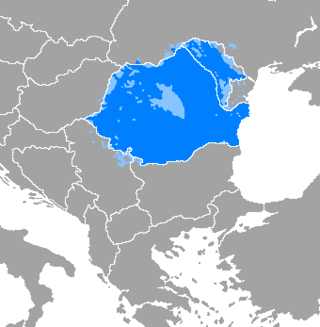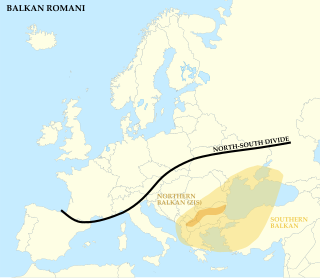This section relies largely or entirely on a single source .(August 2020) |
There are independent groups currently working toward standardizing the Romani language , including groups in Romania, Serbia, the United States and Sweden.
This section relies largely or entirely on a single source .(August 2020) |
There are independent groups currently working toward standardizing the Romani language , including groups in Romania, Serbia, the United States and Sweden.
A standardized form of Romani is used in Serbia. In Serbia's autonomous province of Vojvodina, Romani is one of the officially recognized minority languages – having its own radio stations and news broadcasts.
In Romania, the country with the largest identifiable Romani population, there is now a unified system for teaching the Romani language for all dialects spoken in the country. This is primarily a result of the work of Gheorghe Sarău, who made Romani textbooks for teaching Romani children.
Language standardization is presently also being pursued in the revival of the Romani language among various groups – in Spain, Great Britain and elsewhere – which have ceased to speak the language. In these cases, a specific dialect is not revived, but rather a standardized form derived from many dialects is developed. The Spanish politician Juan de Dios Ramírez Heredia promotes Romanò-Kalò, a variant of Standard Romani with the extant Caló words inserted back, [1] aiming to both the Gitano tradition and communication with other Romani people.
Despite various efforts towards "universal" standardization, the overall trend in Romani literacy is towards regional codification, with some degree of international orientation, in the choice of some graphemes as well as vocabulary.
This international orientation allows Romani readers to appreciate texts composed in other countries. At the same time, this pluralistic approach to codification is representative of the dispersion of Romani communities, and the lack of a central governmental authority. 'Linguistic pluralism' of this kind has been embraced as a policy by the European Roma and Traveller Forum (the elected Romani representation at the Council of Europe) in a statement on its website. It has also received the support of various leading linguists investigating Romani, such as the late Milena Hübschmannová, Dieter W. Halwachs, and Yaron Matras. The RomLex online Romani dictionary acknowledges pluralism by incorporating dialect variants, albeit in a consistent and unified spelling system.
Gheorghe Sarău's standardized Romani, based largely on Eastern European Romani dialects is a purified, mildly prescriptive language, choosing vocabulary and grammatical elements traced back to the old language crystallized in Anatolia.
The pronunciation is most similar to that of the dialects from the first stratum. When there are more variants in the dialects, the variant that most closely resembles the oldest forms is chosen. For example, byav instead of abyav, abyau, akana instead of akanak, shunav instead of ashunav or ashunau, etc.
An effort is also made to derive new words from the vocabulary already in use, i.e., xuryavno (airplane), vortorin (slide rule), palpaledikhipnasko (retrospectively), pashnavni (adjective). There is an ever-changing set of borrowings from Romanian as well, including such terms as vremea (weather, time), primariya (town hall), frishka (cream), sfïnto (saint, holy). Neologisms taken from Hindi include bijli (bulb, electricity), misal (example), chitro (drawing, design), lekhipen (writing) and from English (printisarel, prezidento).

Romanian is the official and main language of Romania and the Republic of Moldova. As a minority language it is spoken by stable communities in the countries surrounding Romania, and by the large Romanian diaspora. In total it is spoken by 28-29 million people as an L1+L2, of whom 23-24 millions are native speakers. In Europe, Romanian is rated as a medium level language, occupying the tenth position among thirty-seven official languages.
Romani is an Indo-Aryan macrolanguage of the Romani communities. According to Ethnologue, seven varieties of Romani are divergent enough to be considered languages of their own. The largest of these are Vlax Romani, Balkan Romani (600,000), and Sinte Romani (300,000). Some Romani communities speak mixed languages based on the surrounding language with retained Romani-derived vocabulary – these are known by linguists as Para-Romani varieties, rather than dialects of the Romani language itself.
Standard High German (SHG), less precisely Standard German or High German, is the standardized variety of the German language used in formal contexts and for communication between different dialect areas. It is a pluricentric Dachsprache with three codified specific regional variants: German Standard German, Austrian Standard German and Swiss Standard German.
A standard language is a language variety that has undergone substantial codification of grammar and usage, although occasionally the term refers to the entirety of a language that includes a standardized form as one of its varieties. Typically, the language varieties that undergo substantive standardization are the dialects associated with centers of commerce and government. By processes that linguistic anthropologists call "referential displacement" and that sociolinguists call "elaboration of function", these varieties acquire the social prestige associated with commerce and government. As a sociological effect of these processes, most users of this language come to believe that the standard language is inherently superior or consider it the linguistic baseline against which to judge other varieties of language.
A dialect continuum or dialect chain is a series of language varieties spoken across some geographical area such that neighboring varieties are mutually intelligible, but the differences accumulate over distance so that widely separated varieties may not be. This is a typical occurrence with widely spread languages and language families around the world, when these languages did not spread recently. Some prominent examples include the Indo-Aryan languages across large parts of India, varieties of Arabic across north Africa and southwest Asia, the Turkic languages, the Chinese languages or dialects, and subgroups of the Romance, Germanic and Slavic families in Europe. Leonard Bloomfield used the name dialect area. Charles F. Hockett used the term L-complex.
This is a list of languages spoken in regions ruled by Balkan countries. With the exception of several Turkic languages, all of them belong to the Indo-European family. A subset of these languages is notable for forming a well-studied sprachbund, a group of languages that have developed some striking structural similarities over time.
A pluricentric language or polycentric language is a language with several interacting codified standard forms, often corresponding to different countries. Many examples of such languages can be found worldwide among the most-spoken languages, including but not limited to Chinese in Mainland China, Taiwan and Singapore; English in the United Kingdom, the United States, India, and elsewhere; and French in France, Canada, and elsewhere. The converse case is a monocentric language, which has only one formally standardized version. Examples include Japanese and Russian. In some cases, the different standards of a pluricentric language may be elaborated until they become autonomous languages, as happened with Malaysian and Indonesian, and with Hindi and Urdu. The same process is under way in Serbo-Croatian.
Angloromani or Anglo-Romani is a mixed language of Indo European origin involving the presence of Romani vocabulary and syntax in the English used by descendants of Romanichal Travellers in the United Kingdom, Australia, Canada, New Zealand, United States, and South Africa.
Caló is a language spoken by the Spanish and Portuguese Romani. It is a mixed language based on Romance grammar, with an adstratum of Romani lexical items through language shift by the Romani community. It is often used as an argot, a secret language for discreet communication amongst Iberian Romani. Catalan, Galician, Portuguese, and Spanish caló are closely related varieties that share a common root.

Standard Spanish, also called the norma culta, 'cultivated norm', refers to the standard, or codified, variety of the Spanish language, which most writing and formal speech in Spanish tends to reflect. This standard, like other standard languages, tends to reflect the norms of upper-class, educated speech. There is variation within this standard, such that one may speak of the Mexican, Latin American, Peninsular or European, and the Rioplatense standards, in addition to the standard forms developed by international organizations and multinational companies.
The Romani language has for most of its history been an entirely oral language, with no written form in common use. Although the first example of written Romani dates from 1542, it is not until the twentieth century that vernacular writing by native Romani people arose.

Languages and dialects spoken in the Serbian province of Vojvodina include South Slavic languages, West Slavic languages (Slovak), East Slavic languages (Rusyn), Hungarian, Romanian, Romani, and others.

The official language of North Macedonia is Macedonian, while Albanian has co-official status. Macedonian is spoken by roughly two-thirds of the population natively, and as a second language by much of the rest of the population. Albanian is the largest minority language. There are a further five national minority languages: Turkish, Romani, Serbian, Bosnian, and Aromanian. The Macedonian Sign Language is the country's official sign language.
Language secessionism is an attitude supporting the separation of a language variety from the language to which it has hitherto been considered to belong, in order to make this variety be considered a distinct language. This phenomenon was first analyzed in Catalan sociolinguistics but it is attested in other parts of the world.

Balkan Romani, Balkaniko Romanes, or Balkan Gypsy is a specific non-Vlax dialect of the Romani language, spoken by groups within the Balkans, which include countries such as Albania, Bosnia-Herzegovina, Bulgaria, Greece, Kosovo, North Macedonia, Serbia, Slovenia, Turkey etc. The Balkan Romani language is typically an oral language.
Juan de Dios Ramírez Heredia is a Spanish politician, of Romani ethnic origin. He is a member of the Spanish Socialist Workers' Party. In 1986-1999 he was a Member of the European Parliament. He was born in Puerto Real, Cádiz.
Para-Romani are various mixed languages of non-Indo-Aryan linguistic classification containing considerable admixture from the Romani language. They are spoken as the traditional vernacular of Romani communities, either in place of, or alongside, varieties of the Romani language. Some Para-Romani languages have no structural features of Romani at all, taking only the vocabulary from Romani.
Sinte Romani is the variety of Romani spoken by the Sinti people in Germany, France, Austria, Belgium, the Netherlands, some parts of Northern Italy and other adjacent regions. Sinte Romani is characterized by significant German influence and is not mutually intelligible with other forms of Romani. The language is written in the Latin script.

Hungarian has ten dialects. These are fully mutually intelligible, and do not differ significantly from standard Hungarian except for the Csángó dialect. They are mostly distinguished by pronunciation; although there are differences in vocabulary, these are usually small and do not hinder intelligibility. Due to increased internal migration and urbanization during the 20th century, most of the characteristics of the different dialects can only be observed in smaller towns and villages, and even there mostly among the elderly; the population of the larger cities and especially the capital has been mixed for generations and the dialectal differences have been lost. A notable exception is the Western Transdanubian pronunciation, which is distinctly noticeable even in Szombathely, the largest city in the region.